牛津上海版英语九年级上册课件:Unit 2 Trditional skills Grammar(共20张PPT)
文档属性
| 名称 | 牛津上海版英语九年级上册课件:Unit 2 Trditional skills Grammar(共20张PPT) |  | |
| 格式 | zip | ||
| 文件大小 | 15.3MB | ||
| 资源类型 | 教案 | ||
| 版本资源 | 牛津上海版(试用本) | ||
| 科目 | 英语 | ||
| 更新时间 | 2016-06-20 22:53:13 | ||
图片预览

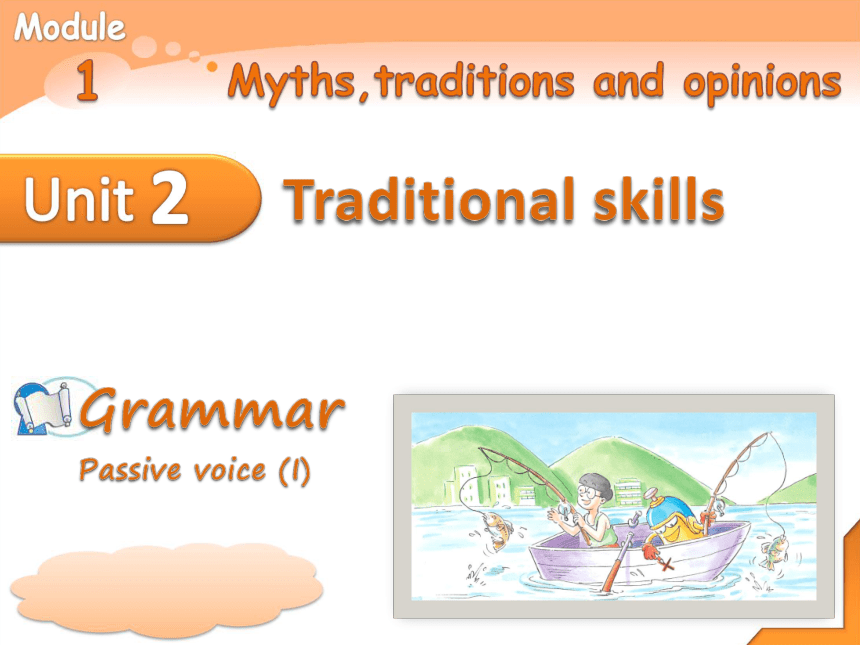
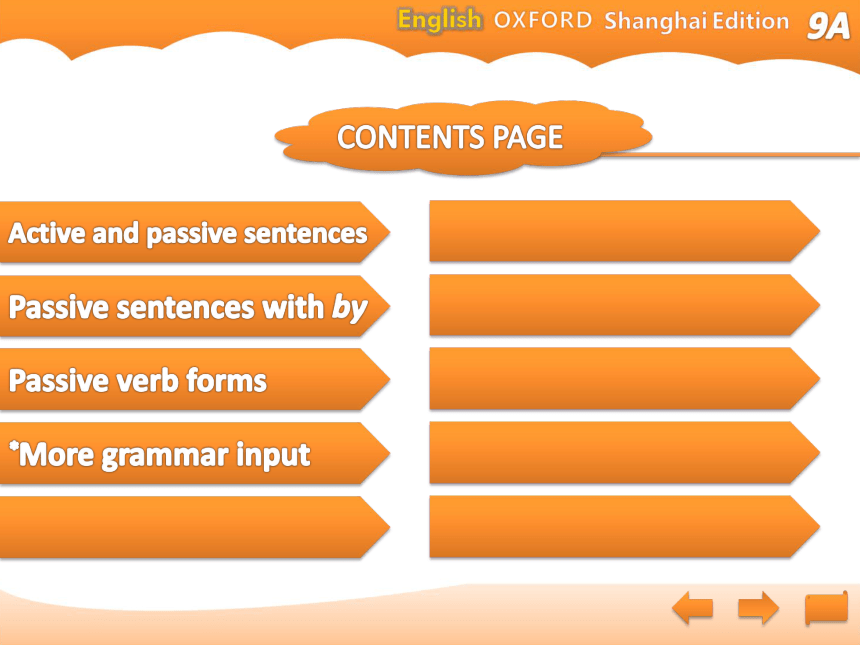

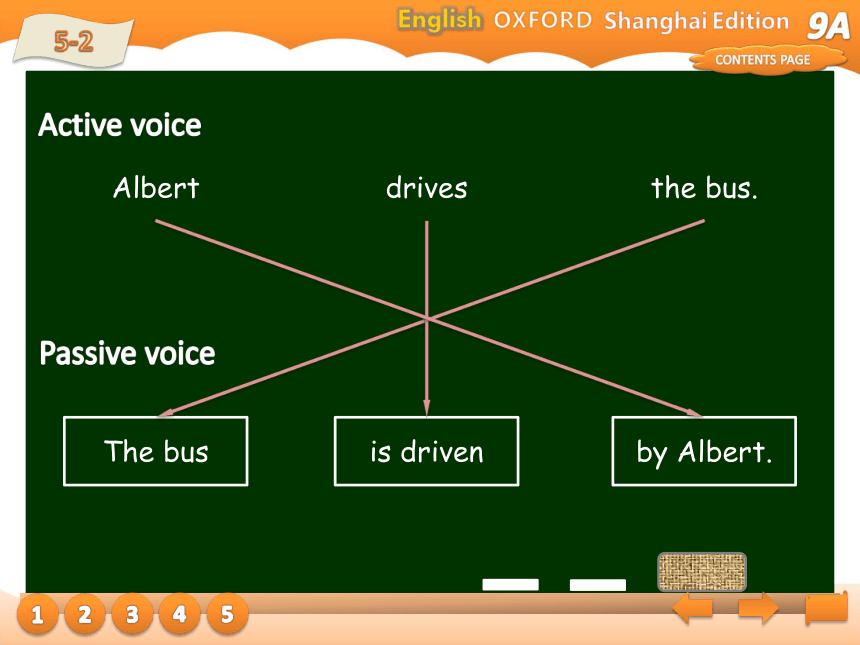

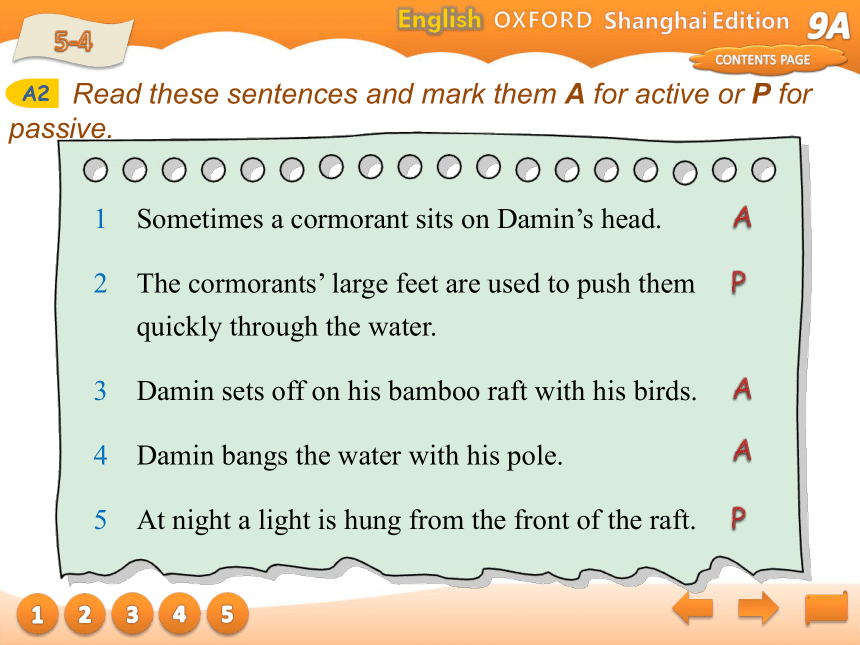

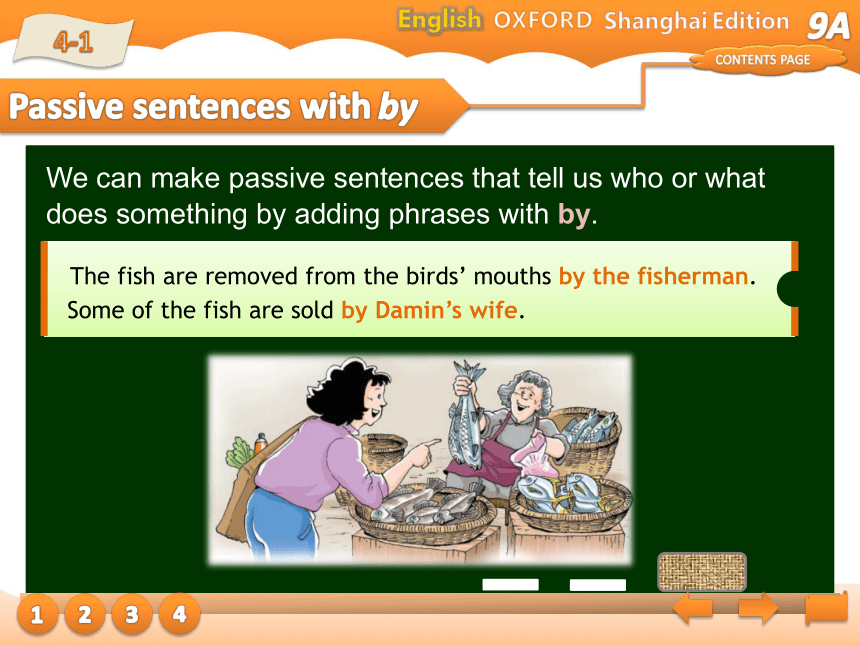
文档简介
课件20张PPT。1Myths,traditions and opinionsGrammar
Passive voice (I)2Traditional skillsCONTENTS PAGEActive and passive sentencesPassive sentences with byPassive verb forms*More grammar inputActive and passive sentences5-11234Active sentences tell us who or what does something.5Passive sentences often do not tell us who or what does something.5-212345Albertdrivesthe bus.The busis drivenby Albert.Active voicePassive voice Answer these questions, saying what or who does each thing.A15-312345Who tied a piece of grass around the neck of each bird?
What catch fish for Damin?
What frightens the fish?
Who removes the fish from the cormorants’ mouths?
Who is teaching his grandson everything he knows?Damin.Cormorants.The noise (of Damin jumping and banging the water).Damin.Damin. Read these sentences and mark them A for active or P for passive.A25-412345Sometimes a cormorant sits on Damin’s head.
The cormorants’ large feet are used to push them quickly through the water.
Damin sets off on his bamboo raft with his birds.
Damin bangs the water with his pole.
At night a light is hung from the front of the raft.APAAP Complete each blank in this passage with is or are and one of the verbs from the box. The first one has been done for you.A35-512345looked after
not allowed
examined
controlled
removed
watched
hatched
raised
taken
fedis raisedare examinedis removedis hatchedis watchedis looked afteris fedis controlledare not allowedis takenPassive sentences with by4-1123We can make passive sentences that tell us who or what does something by adding phrases with by.4 Complete this passage using phrases with by and the words in the box.B14-2123these paintings
shop assistants
businessmen
tourists
artistsby artistsby businessmenby shop assistantsby touristsby these paintings4 Rewrite these newspaper headlines using the present passive tense + by. The first one has been done for you.B24-3123________________________________________________________
________________________________________________________
________________________________________________________Crops in the countryside are hit by the cold weather.Two robbers are arrested by a bank customer.A Grade One boy is bitten by a dangerous dog.4_______________________________________________________
_______________________________________________________
_______________________________________________________
_______________________________________________________
_______________________________________________________4-4123Two small villages are cut off by a flood.A ¥10,000 prize is won by a taxi driver.4Higher bus fares are allowed by the government.Valuable jewels are stolen by a young woman.Sunhill Road is closed by a fire.We make passive verb forms from to be and the past participles of verbs.Passive verb forms4-11234 A film crew from France decided to make a programme about Damin. Complete the passage using the words and pictures below to help you. Put the verbs in the past passive form and use phrases with by to show who (what) performed each action. The first one has been done for you.C14-212344-31234transport interview employ choose film usewas employed by the French producerwere interviewed by the interpreterwas chosen by the producerwere transported by lorrywas used by the cameramanwas filmed by the crew Below is what the French producer said to Damin after the filming. (The interpreter then translated it into Chinese, of course.) Complete his words by using these verbs in the future passive form.C24-41234make see translate take show addwill be takenwill be addedwill be madewill be translatedwill be shownwill be seenThe passive voice is also used in the following situations:If we do not know who is responsible for an action.*More grammar input2-112When we wish to avoid blaming ourselves or someone in particular. For example, if a child breaks a window, he will probably say:2-212When we cannot (for legal reasons) say who was responsible for something. This is common in newspaper stories.When it is completely unimportant who did the action.When using scientific English where the focus is on the experiment itself, not those who perform it.ConsolidationWorkbook 9A, pages 12, 13, 14, 15 and 16.
说 明
本册教材根据上海市中小学(幼儿园)课程改革委员会制订的课程方案和《上海市中小学英语课程标准(征求意见稿)》编写,供九年义务教育九年级第一学期试用。
本教材经上海市中小学教材审查委员会审查准予试用。
《英语(牛津上海版)》(试用本)
主 编:沃振华
原 作 者:P Etherton G McArthur P Leetch
改编人员:沃振华 朱维庭 李绍贤 施安吉 施志红
奚翠华 卢 璐 张 瑶
牛津大学出版社(中国)有限公司英语教材编写委员会
责任编辑:马芳芳 林 妍
插 图:K Y Chan 周允达
课件制作:卢 璐
支持学校:上海市市北初级中学
Passive voice (I)2Traditional skillsCONTENTS PAGEActive and passive sentencesPassive sentences with byPassive verb forms*More grammar inputActive and passive sentences5-11234Active sentences tell us who or what does something.5Passive sentences often do not tell us who or what does something.5-212345Albertdrivesthe bus.The busis drivenby Albert.Active voicePassive voice Answer these questions, saying what or who does each thing.A15-312345Who tied a piece of grass around the neck of each bird?
What catch fish for Damin?
What frightens the fish?
Who removes the fish from the cormorants’ mouths?
Who is teaching his grandson everything he knows?Damin.Cormorants.The noise (of Damin jumping and banging the water).Damin.Damin. Read these sentences and mark them A for active or P for passive.A25-412345Sometimes a cormorant sits on Damin’s head.
The cormorants’ large feet are used to push them quickly through the water.
Damin sets off on his bamboo raft with his birds.
Damin bangs the water with his pole.
At night a light is hung from the front of the raft.APAAP Complete each blank in this passage with is or are and one of the verbs from the box. The first one has been done for you.A35-512345looked after
not allowed
examined
controlled
removed
watched
hatched
raised
taken
fedis raisedare examinedis removedis hatchedis watchedis looked afteris fedis controlledare not allowedis takenPassive sentences with by4-1123We can make passive sentences that tell us who or what does something by adding phrases with by.4 Complete this passage using phrases with by and the words in the box.B14-2123these paintings
shop assistants
businessmen
tourists
artistsby artistsby businessmenby shop assistantsby touristsby these paintings4 Rewrite these newspaper headlines using the present passive tense + by. The first one has been done for you.B24-3123________________________________________________________
________________________________________________________
________________________________________________________Crops in the countryside are hit by the cold weather.Two robbers are arrested by a bank customer.A Grade One boy is bitten by a dangerous dog.4_______________________________________________________
_______________________________________________________
_______________________________________________________
_______________________________________________________
_______________________________________________________4-4123Two small villages are cut off by a flood.A ¥10,000 prize is won by a taxi driver.4Higher bus fares are allowed by the government.Valuable jewels are stolen by a young woman.Sunhill Road is closed by a fire.We make passive verb forms from to be and the past participles of verbs.Passive verb forms4-11234 A film crew from France decided to make a programme about Damin. Complete the passage using the words and pictures below to help you. Put the verbs in the past passive form and use phrases with by to show who (what) performed each action. The first one has been done for you.C14-212344-31234transport interview employ choose film usewas employed by the French producerwere interviewed by the interpreterwas chosen by the producerwere transported by lorrywas used by the cameramanwas filmed by the crew Below is what the French producer said to Damin after the filming. (The interpreter then translated it into Chinese, of course.) Complete his words by using these verbs in the future passive form.C24-41234make see translate take show addwill be takenwill be addedwill be madewill be translatedwill be shownwill be seenThe passive voice is also used in the following situations:If we do not know who is responsible for an action.*More grammar input2-112When we wish to avoid blaming ourselves or someone in particular. For example, if a child breaks a window, he will probably say:2-212When we cannot (for legal reasons) say who was responsible for something. This is common in newspaper stories.When it is completely unimportant who did the action.When using scientific English where the focus is on the experiment itself, not those who perform it.ConsolidationWorkbook 9A, pages 12, 13, 14, 15 and 16.
说 明
本册教材根据上海市中小学(幼儿园)课程改革委员会制订的课程方案和《上海市中小学英语课程标准(征求意见稿)》编写,供九年义务教育九年级第一学期试用。
本教材经上海市中小学教材审查委员会审查准予试用。
《英语(牛津上海版)》(试用本)
主 编:沃振华
原 作 者:P Etherton G McArthur P Leetch
改编人员:沃振华 朱维庭 李绍贤 施安吉 施志红
奚翠华 卢 璐 张 瑶
牛津大学出版社(中国)有限公司英语教材编写委员会
责任编辑:马芳芳 林 妍
插 图:K Y Chan 周允达
课件制作:卢 璐
支持学校:上海市市北初级中学
